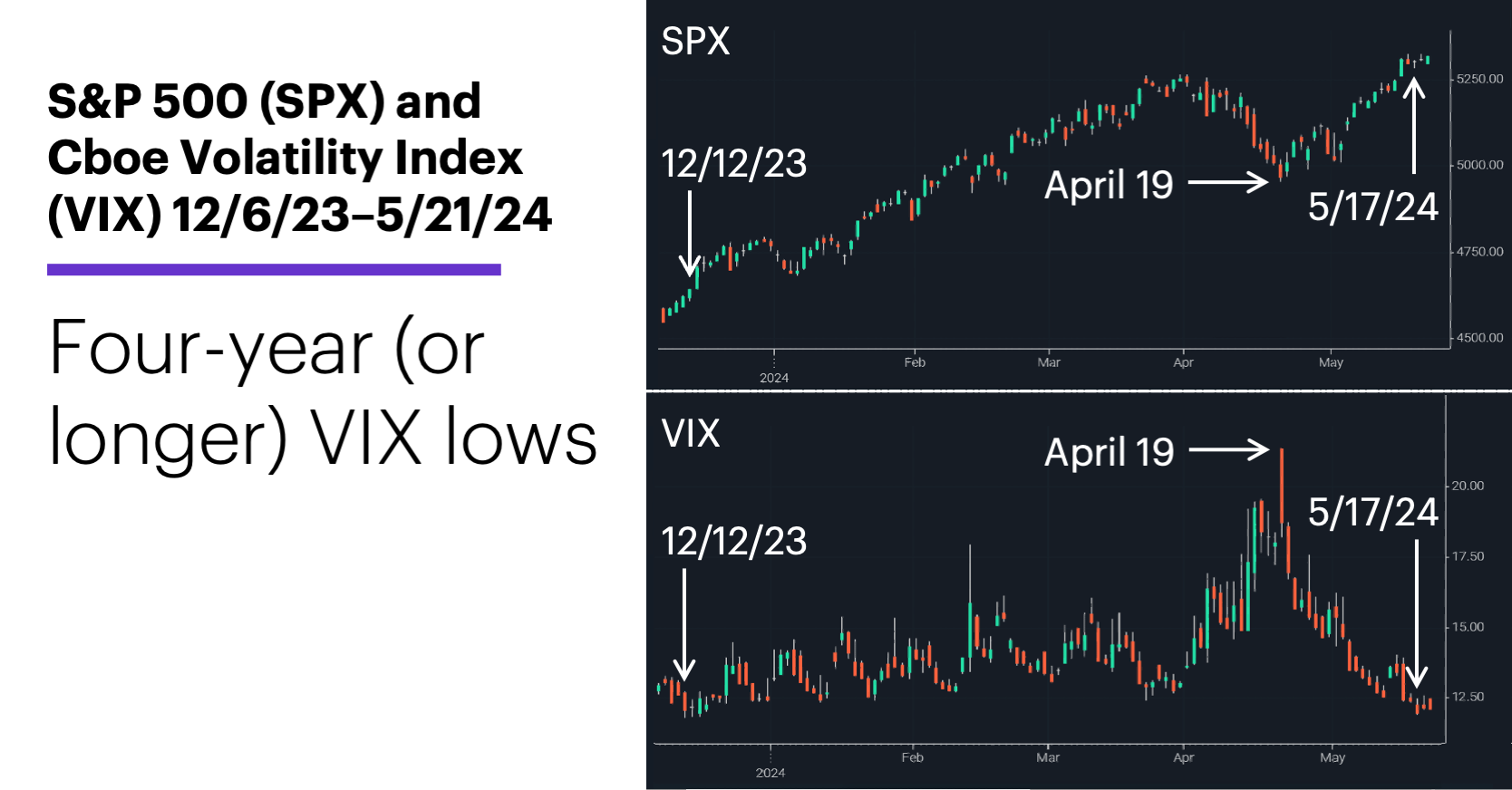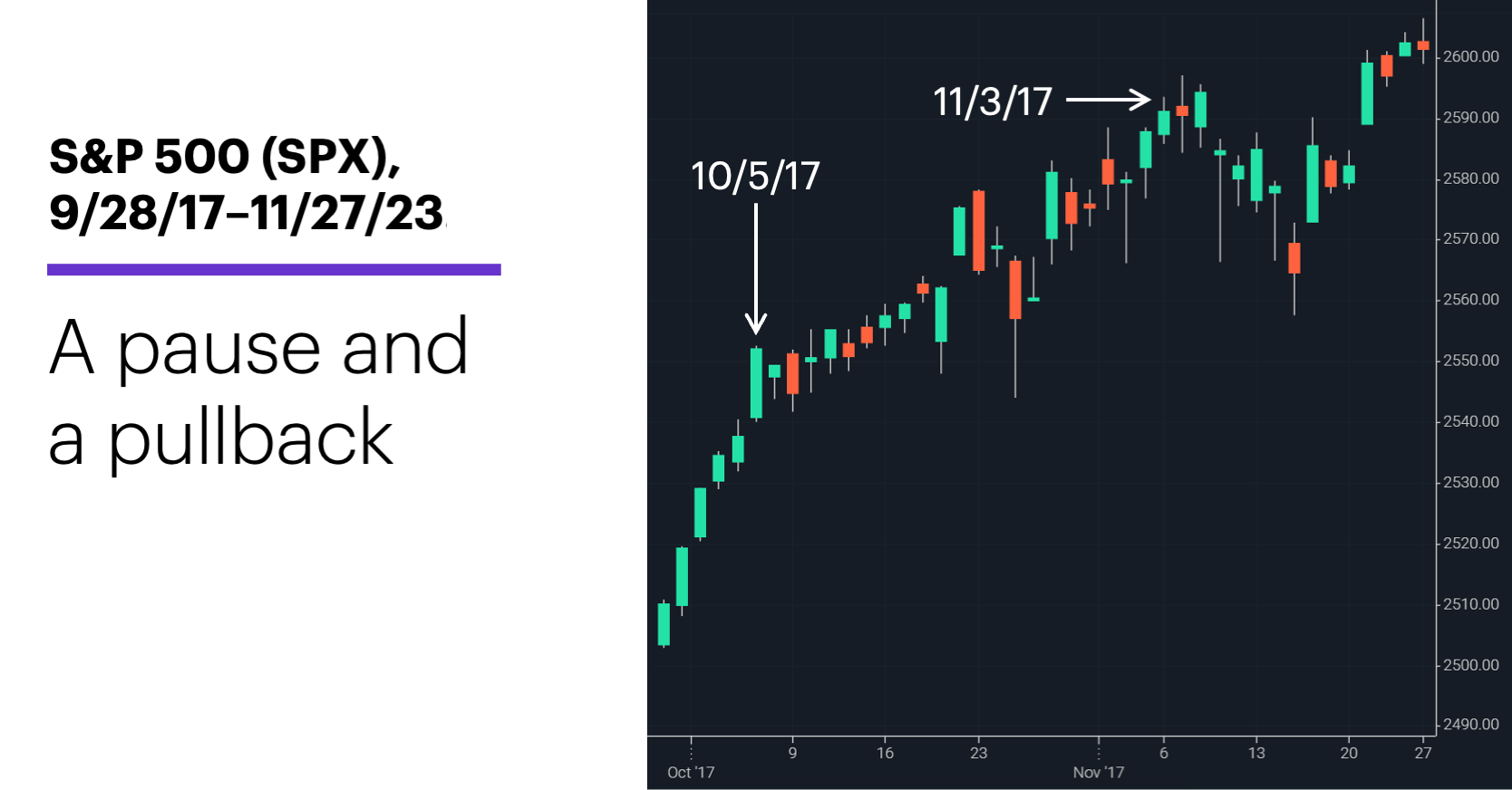Market at highs, VIX at lows
- Cboe Volatility Index (VIX) near multi-year lows
- S&P 500 has consolidated since latest VIX dip
- Level less important than relationship to past lows?
On April 19, the Cboe Volatility Index (VIX) tagged its highest level (21.36) since late October. As of Tuesday, the S&P 500 had rallied as much as 6.9% above its April 19 close, hitting record highs in the process. Last Friday, the VIX closed at its lowest level (11.99) since November 2019. A possible signal the rally was running out of steam?
Unfortunately, there’s no solid evidence that specific VIX thresholds signal turning points for the stock market. True, the VIX often jumps during sharp market sell-offs, but history shows it’s impossible to say a VIX reading of, say, 25 (vs. 30, 35 or 36, etc.) can reliably signal the end of a down move. The same goes for a specific low VIX signaling a rally has transitioned from “healthy” to “overbought.”
So, while the VIX closing below 12 on Friday may have seemed significant, crossing that threshold may actually obscure some of the volatility index’s more useful information. Since 1990, there have been 140 other times the VIX has closed below 12 after closing above it a day earlier. The SPX was higher a week later 51% of the time, with an average return of 0.1%.1
Looking at how high or low the VIX is on a relative basis can sometimes be more rewarding. For example, Friday’s close was its lowest in four-and-a-half years:

Source: Power E*TRADE (For illustration purposes. Not a recommendation. Note: It is not possible to invest in an index.)
Since 1990, the VIX has closed at a four-year (or longer) low 39 other times, most recently on December 12. There certainly wasn’t a short-term slowdown after that signal—the SPX gained 2.7% over the next five days, consolidated for a few weeks, and ultimately extended its rally to more than 13% by March.
The two previous times the VIX closed at its lowest level in at least four years occurred in late 2017. As the chart below shows, the strong rally that preceded the October example slowed a bit immediately after it, with the SPX closing slightly (-0.04%) lower a week later. In the November example, the SPX pushed a little higher before experiencing a run-of-the-mill pullback, then pushing to fresh highs:

Source: Power E*TRADE (For illustration purposes. Not a recommendation. Note: It is not possible to invest in an index.)
The SPX’s short-term slowdown after the October 2017 example may be the most representative of the market’s typical performance after the 39 total signals. One week later, the SPX was lower 20 times and higher 19 times, with an average return of -0.07%.1
The VIX is a widely watched indicator, and with good reason. Options volatility can sometimes provide insights into market dynamics that may not be obvious when looking only at index or individual stock prices. But it’s just one tool, and it simply signals when the odds may favor a certain type of market action.
Market Mover Update: Morgan Stanley & Co. strategists see the possibility of a June rate cut—for the European Union. In the US, they’re targeting September for the Fed’s first cut, describing Q1’s high inflation as “more noise than signal,” and anticipating the disinflation trend will pick up as the year progresses.2
On Tuesday, copper prices hit a record high for the fifth time in the past six days, although many copper-mining stocks didn’t participate in the day’s gains (see “Metals, miners, and AI”).
Today’s numbers include (all times ET): mortgage applications (7 a.m.), Austan Goolsbee speech (9:40 a.m.), Existing Home Sales (10 a.m.), Atlanta Fed Business Inflation Expectations (10 a.m.), EIA Petroleum Status Report (10:30 a.m.), FOMC minutes (2 p.m.).
Today’s earnings include: Analog Devices (ADI), Dycom (DY), Target (TGT), TJX (TJX), Nvidia (NVDA), Snowflake (SNOW).
Click here to log on to your account or learn more about E*TRADE's trading platforms, or follow the Company on Twitter, @ETRADE, for useful trading and investing insights.
1 All figures reflect Cboe Volatility Index (VIX) and S&P 500 (SPX) daily prices, 1971–2024. Supporting document available upon request.
2 MorganStanley.com. Midyear Economic Outlook: Reasons for Optimism. 5/14/24.